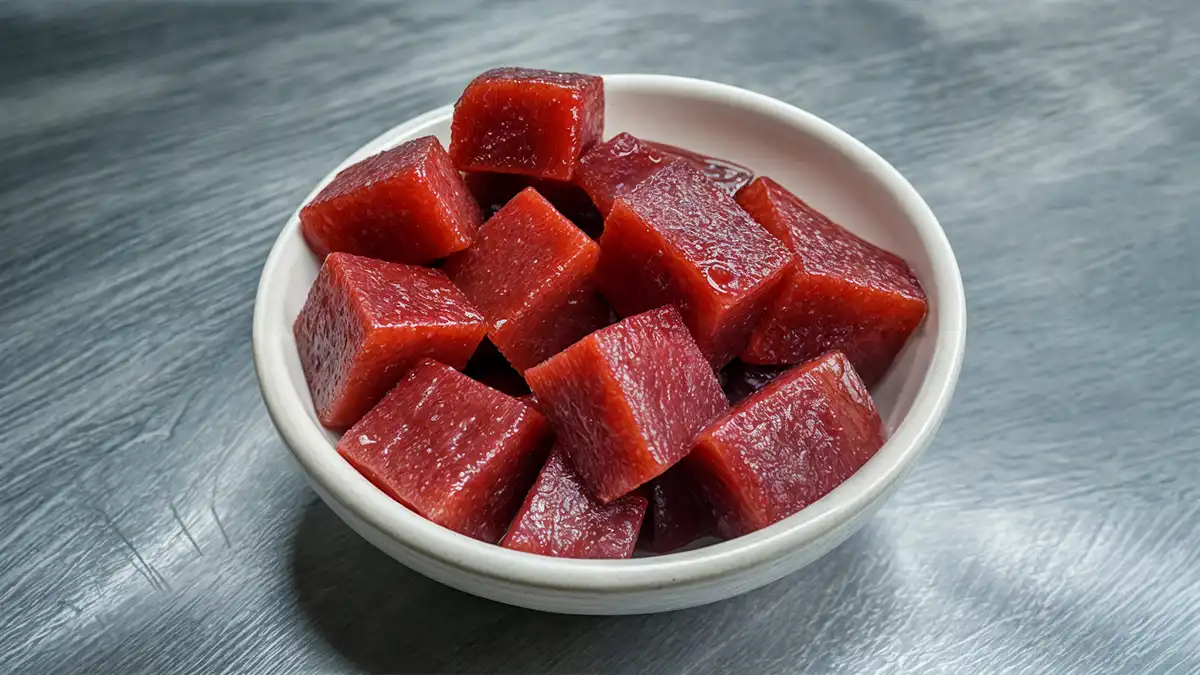Guava paste recipe, get into the guava groove and make your own deliciousness that’s as full of culture as it is full of flavour! This tropical treasure is often overlooked in favour of more common fruit preserves but it deserves a spot in your kitchen. Whether you’re a seasoned chef or a foodie looking to spice up your repertoire this will give you everything you need to add some tropical zing to your cooking.
Table of Contents
| Section | Content |
|---|---|
| Introduction | Overview of guava paste, its cultural significance, and culinary uses. |
| Gathering Your Ingredients and Tools | Essential ingredients and kitchen tools needed to make guava paste. |
| Step-by-Step Guide | Detailed cooking instructions for creating guava paste from scratch. |
| Cooling and Storing | Best practices for cooling and long-term storage of guava paste. |
| Culinary Uses and Pairings | Creative ideas for using guava paste in various dishes and pairings. |
| FAQs | Answers to common questions related to making and using guava paste. |
Why Make Your Own Guava Paste?
Imagine spreading smooth, rich guava paste over crispy toast or pairing it with sharp, creamy cheese. This versatile confection can turn any meal into a gourmet delight. Plus, making guava paste recipe at home lets you control the ingredients, perfect for those who prefer a less sugary, more natural alternative to store-bought versions.
The Cultural Significance of Guava Paste Recipe
In many cultures, guava paste recipe is more than just food; it’s a festive treat that evokes memories of family gatherings. From Brazil’s sunlit fields to Colombia’s bustling markets, guava paste is a nostalgic confection and a symbol of hospitality. As we recreate this beloved treat, we celebrate the rich cultural tapestry it represents.
Here’s a quick glimpse of the variety of guavas and how their unique characteristics influence the final product of our guava paste recipe:
| Type of Guava | Flavor Profile | Best Used For |
|---|---|---|
| Pink Guavas | Sweet and vibrant | Richly flavored guava paste |
| White Guavas | Mild and subtle | Lighter, delicate pastes |
| Red Guavas | Deep and aromatic | Intense, flavorful pastes |
Gathering Your Ingredients and Tools for Guava Paste Recipe
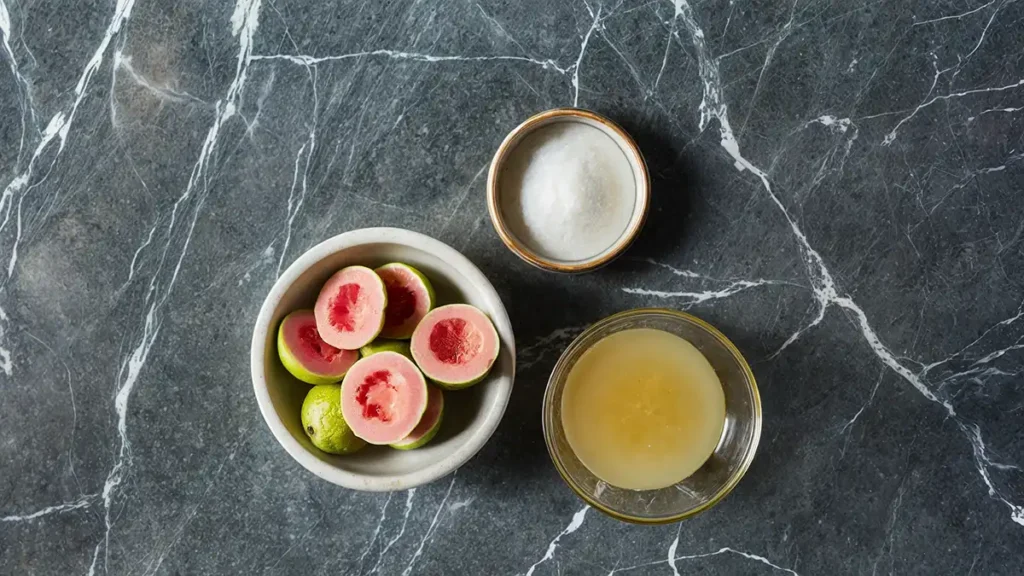
First up, the star of our show—guavas. Choosing the right guavas is key to the perfect flavor and texture of your paste. Here’s what you’ll need for a basic yet fantastic batch of guava paste:
- Fresh Guavas: About 2 pounds (make sure they’re ripe and aromatic!)
- Granulated Sugar: Equal weight to the guavas after they’ve been prepped.
- Lemon Juice: For that zesty kick and to help preserve the paste.
Pro Tip: If you want to add a little twist to your guava paste, try incorporating ingredients like vanilla extract or a splash of rum for an extra layer of flavor.
Kitchen Equipment Checklist
Now, let’s talk tools. To make your cooking experience as smooth as the paste we aim to create, you’ll need a few kitchen staples:
- Heavy-Bottomed Pan: Keeps the cooking even and prevents burning.
- Blender or Food Processor: For pureeing the guavas to perfection.
- Fine Mesh Strainer: Essential for achieving that silky smooth texture by removing seeds.
- Parchment Paper: To line the tray for easy removal and storage of the paste.
- Sharp Knife: For cutting the set paste into blocks or slices.
How to Select the Perfect Guava For Your Guava Paste Recipe
Choosing the right guava is key. Go for fruits that are soft to the touch with a sweet, floral aroma. Avoid those that are overly soft or blemished. Quality guavas will make your paste shine. For more tips on selecting the best guavas, check out this comprehensive guide: How to Choose the Perfect Guava.
Linking Guava with Gastronomy
Now that you’re set to make your own guava paste, consider pairing it with other dishes. Spread your homemade guava paste on a crispy slice of sandwich sourdough bread. This simple yet elegant combo can turn a casual snack into a chic appetizer or a sweet and savory dessert.
Step-by-Step Guide to Making Guava Paste
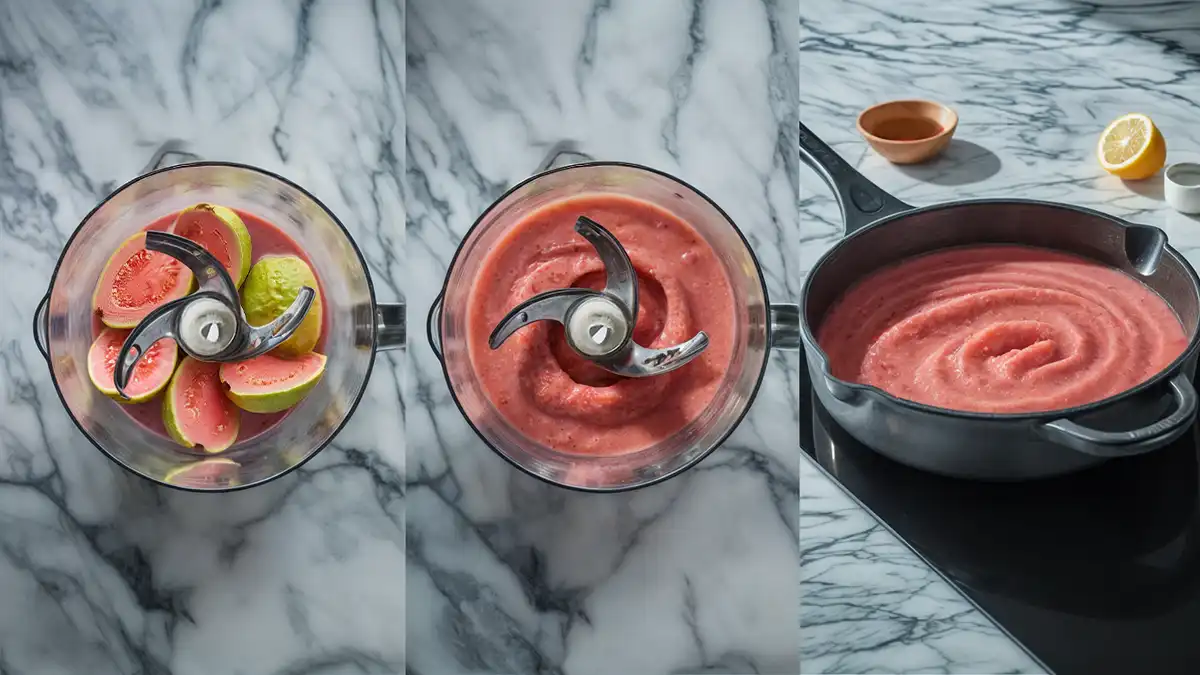
With our ingredients and tools ready, let’s dive into the delicious process of making guava paste. Follow these simple steps, and you’ll be enjoying your homemade treat in no time!
Preparing the Guavas
- Wash and Peel: Begin by thoroughly washing the guavas. Peel them if you prefer a smoother paste, although the peel can add a nice depth of flavor and extra pectin, which helps in setting the paste.
- Cut and Deseed: Cut the guavas into halves and scoop out the seeds. Remember, the seeds can make the paste gritty, so it’s best to remove them.
Cooking Down the Guavas
- Puree the Fruit: Using a blender or food processor, puree the guava halves until smooth. You can add a little water to help the blades run smoothly.
- Cook the Puree: Transfer the guava puree into your heavy-bottomed pan. Add sugar and lemon juice according to taste, usually equal weight to the prepared fruit.
- Simmer: Cook the mixture on medium heat, stirring frequently to prevent it from sticking to the bottom of the pan. The sugar and natural pectins in the guava will slowly turn the puree into a thick, glossy paste.
Setting the Paste
- Test the Consistency: To check if the paste is ready, drop a small amount on a cold plate; it should not run and should hold its shape.
- Prepare for Setting: Once the guava mixture has thickened adequately, pour it into a tray lined with parchment paper. Spread evenly.
- Cool and Set: Allow the paste to cool at room temperature, then transfer it to the refrigerator to set completely, usually overnight.
Enjoying Your Homemade Guava Paste
Now that your guava paste is ready, it’s time to enjoy it! Spread it on toast, pair it with cheese, or use it as a pastry filling. For a creative twist, try this fantastic Jamaican Beef Patty Recipe, where fruity flavors enhance the savory filling.
For a visual guide to making guava paste, check out this helpful tutorial:
Cooling and Storing Your Homemade Guava Paste
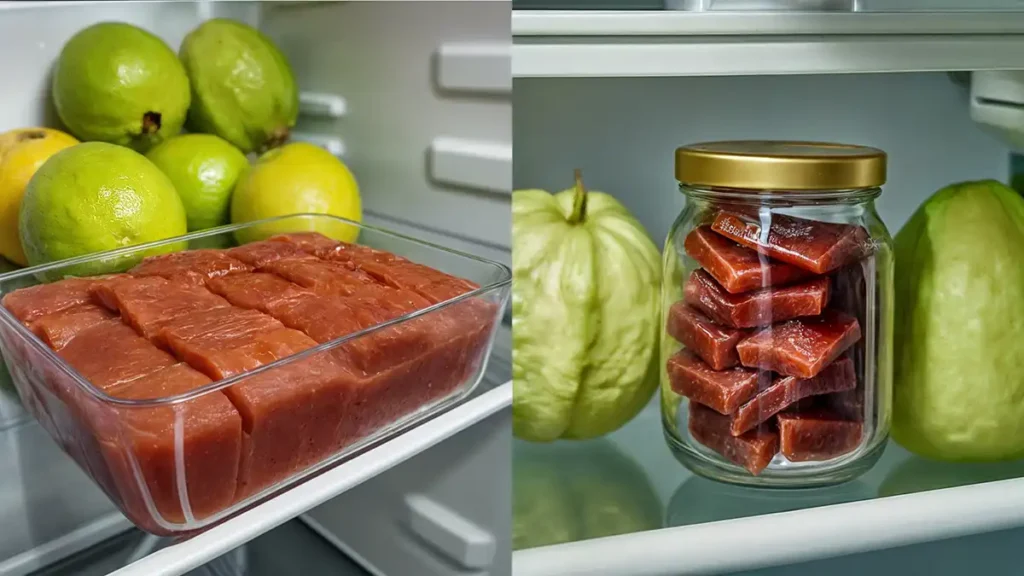
After making your guava paste, proper cooling and storage are key to maintaining its flavor and texture. Here are the best practices to keep it fresh and ready to enjoy whenever the craving strikes.
Proper Cooling Techniques
- Room Temperature Cooling:
- Once poured into the parchment-lined tray, allow your guava paste to cool at room temperature until it reaches a manageable warmth. This gradual cooling helps prevent the formation of sugar crystals, ensuring a smooth texture.
- Refrigeration:
- After cooling to room temperature, transfer the guava paste to the refrigerator. This step is crucial as it helps the paste to fully set, creating a firm texture that is easy to slice.
Long-Term Storage Solutions
- Refrigerator Storage:
- For short-term storage, wrap the guava paste tightly in plastic wrap or parchment paper and place it in an airtight container. Stored this way, the paste can last up to three months in the refrigerator.
- Freezer Option:
- If you plan to keep the guava paste longer, freezing is a great option. Wrap individual slices or blocks in parchment, then place them in a freezer-safe bag or container. Frozen guava paste can be kept for up to six months. Always thaw in the refrigerator before use to maintain its best quality.
Maintaining Optimal Freshness
- Check Regularly:
- Periodically check on your guava paste, especially if stored in the refrigerator. Look for any signs of moisture or mold, which can indicate that the storage conditions are not optimal.
- Optimal Humidity:
- Ensure your refrigerator or freezer is set to a low humidity to prevent the guava paste from absorbing moisture and becoming too soft or runny.
Serving Suggestions
Once your guava paste is ready, the possibilities are endless! Spread it on a warm slice of sandwich sourdough bread for a tasty snack, or use it as a filling for baked goods. Guava paste pairs wonderfully with cheese, making it a perfect addition to a cheese board for entertaining.
Culinary Uses and Pairings for Homemade Guava Paste
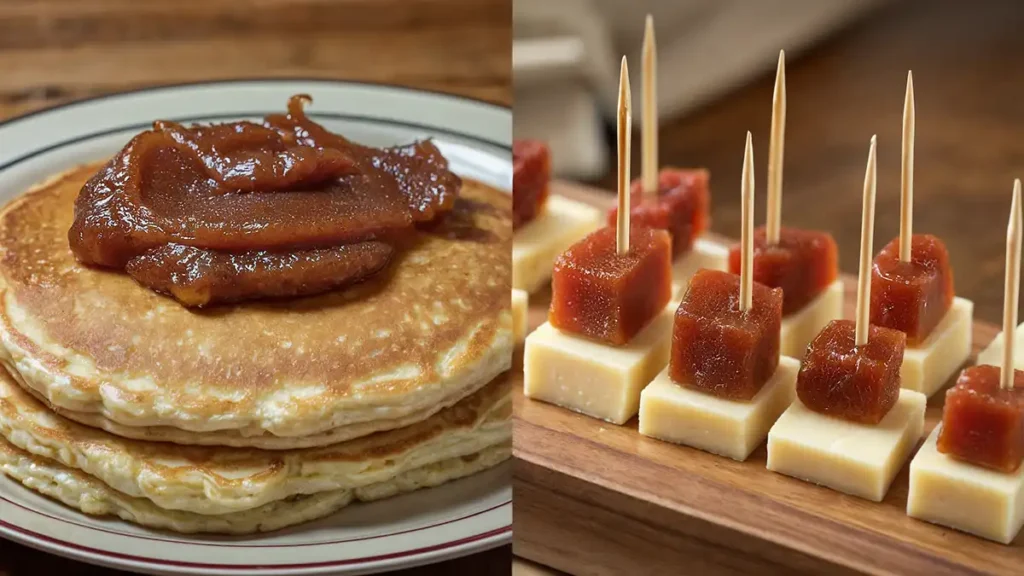
Once you’ve mastered guava paste, the fun part begins—using it to create mouthwatering dishes! This versatile treat adds sweet and tangy flavor to both savory and sweet recipes. Here’s how to incorporate it into your culinary repertoire.
Pairings That Pop
- Cheese Pairings:
- Guava paste and cheese are a match made in heaven. The sweetness of the paste perfectly complements the creaminess of cheeses. Try it with Boursin cheese for a decadent treat or with milder cheeses like cream cheese or mozzarella for a balanced flavor.
- Snack Time Delight:
- For a quick and easy snack, spread guava paste on some cracker barrel pancakes or crackers. It’s perfect for an afternoon pick-me-up or a fancy party snack.
Creative Culinary Uses
- In Baked Goods:
- Guava paste can be used as a filling for pastries, adding a tropical twist to traditional recipes. Consider making turnovers or stuffing it into Crumbl sugar cookies for a sweet surprise.
- As a Glaze or Sauce:
- Reduce guava paste with a little water or citrus juice to make a glaze for meats or desserts. This glaze is perfect for adding a touch of sweetness to pork riblets or drizzling over ice cream for a unique dessert.
Table: Top Pairings for Guava Paste
| Dish Type | Suggested Use | Ideal Pairing |
|---|---|---|
| Cheese Boards | As a spread alongside various cheeses | Boursin, Cream Cheese |
| Baked Goods | Filling for pastries, cookies, and breads | Sugar Cookies, Puff Pastries |
| Savory Dishes | Glaze for meats, especially pork and chicken | Pork Riblets, BBQ Chicken |
| Desserts | Topping for ice creams or incorporated into bars | Vanilla Ice Cream, Cheesecakes |
FAQs About Guava Paste Recipe
What do you do with guava paste?
Guava paste is a versatile, rich confection adding sweet and tangy flavor to dishes. Use it as a spread on crackers or bread, pair with cheese, fill pastries, or glaze meats for a tropical twist.
How to turn guava pulp into paste?
To make guava paste, cook guava pulp with sugar until it thickens and reduces. Simmer on low heat, stirring often to prevent burning, until thick, glossy, and holds its shape when cooled, about an hour.
How to make guava paste for face?
Guava fruit is great for skin care due to its high vitamin C. To make a guava face mask, blend guava flesh with water until smooth, then mix with honey or oatmeal. Note, this is different from the sugary guava paste used in cooking.
Can you eat guava paste raw?
Yes, guava paste can be eaten raw and is often enjoyed as is, especially when served as part of a cheese platter or used as a snack spread. It’s sweet, dense, and has a texture similar to that of firm jelly or fruit preserves.
Conclusion
Thanks for diving into the sweet world of guava paste with me! I hope these tips and ideas inspire you to experiment with this delightful treat in your kitchen. Whether you’re spreading it on toast, mixing it into pastries, or enjoying it with cheese, guava paste is sure to add a burst of flavor to your dishes. Got any more questions or unique ways you use guava paste? Drop a comment below and share your thoughts—I’d love to hear from you! Thanks for reading!

